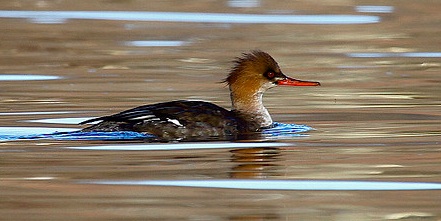
Red-breasted Merganser, Ryan Schain
Continental Summary
A quiet late season week in the West saw primarily light movements west of the Rockies featuring Brant, Red-breasted Merganser, Pacific Loon, Mew Gull, Bohemian Waxwing, Chestnut-collared Longspur, Grasshopper Sparrow, and Clay-colored Sparrow, while early and late period movements of moderate to heavy intensity in the East featured numerous waterfowl, Rough-legged Hawk, Northern Shrike, Cedar Waxwing, American Tree Sparrow, and Fox Sparrow.
Curious what birds will move next? Check out our forecast.
Need a review of our definitions for regions, species on the move, and migration amounts? Please visit this link.
Quick Links to Regions
Upper Midwest and Northeast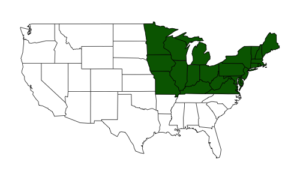 |
Gulf Coast and Southeast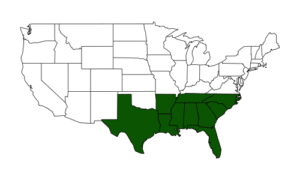 |
Great Plains |
West |

Eastern Bluebird, Ryan Schain
Upper Midwest and Northeast
Southerly and southwesterly flow dominated the scene this week in the region, and most movements that occurred were primarily light to moderate. In areas where winds were lighter than expected, slightly more intense migration occurred, for example Sunday night in the Ohio River valley region and Tuesday and Wednesday nights in the mid Atlantic states. By Thursday night, a sign of life for remaining fall migrants appeared in the midwest, where moderate to locally heavy flights occurred locally after the passage of a frontal boundary.
Top Movers
Increasing
| Species | Increase from Last Week | % of Checklists Reporting |
|---|---|---|
| American Tree Sparrow | 49% | 6.9 |
| American Goldfinch | 21% | 41.7 |
| Dark-eyed Junco | 25% | 37.9 |
| Cedar Waxwing | 30% | 15.4 |
| Purple Finch | 26% | 4.1 |
| Dickcissel | 103% | 0.5 |
| Eastern Bluebird | 21% | 16.1 |
| Purple Sandpiper | 175% | 0.2 |
| Fox Sparrow | 31% | 5 |
| Yellow-breasted Chat | 122% | 0.2 |
Decreasing
| Species | Decrease from Last Week | % of Checklists Reporting |
|---|---|---|
| Pectoral Sandpiper | -68% | 0.5 |
| Tree Swallow | -59% | 1.4 |
| White-rumped Sandpiper | -71% | 0.2 |
| Vesper Sparrow | -66% | 0.2 |
| Eastern Phoebe | -48% | 1.5 |
| Palm Warbler | -42% | 1.5 |
| Osprey | -58% | 0.7 |
| Least Sandpiper | -67% | 0.2 |
| Turkey Vulture | -24% | 12.6 |
| Great Egret | -27% | 2.6 |
| Blue-headed Vireo | -62% | 0.3 |
| Sharp-shinned Hawk | -25% | 4.7 |
| Wood Duck | -22% | 5.9 |
| Semipalmated Sandpiper | -90% | 0 |
| Lincoln's Sparrow | -50% | 0.5 |
| Merlin | -33% | 1.8 |
| Yellow-rumped Warbler | -18% | 14.5 |
| Dunlin | -24% | 3 |
| Ruby-crowned Kinglet | -18% | 7.1 |
| Chipping Sparrow | -22% | 3.6 |
| Royal Tern | -31% | 1 |
| American Wigeon | -22% | 3.6 |
| Semipalmated Plover | -40% | 0.4 |
| Greater Yellowlegs | -17% | 4.6 |
| Franklin's Gull | -50% | 0.3 |
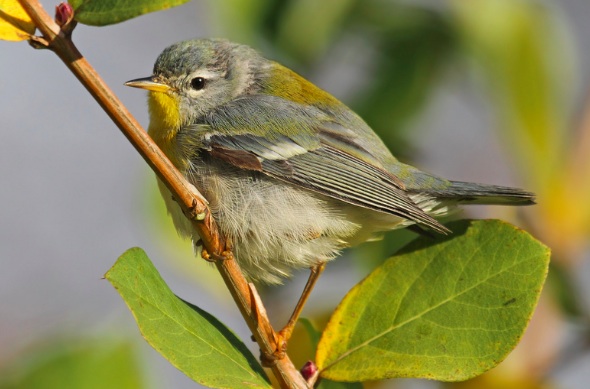
Northern Parula, Ryan Schain
Gulf Coast and Southeast
Moderate to heavy flights kicked off the period for areas east of the Mississippi River. However, the days that followed saw a drastic change in the intensity and distribution of movements. A slow moving front shut down most movements east of the Mississippi River outside of Florida from Saturday through Monday. Behind this front, moderate flights occurred over Texas and Louisiana. By Monday night, the front had shifted far enough to the east to allow most areas west of the Appalachians to experience moderate flights. But persistent warm temperatures and a lack of input from points farther north brought diminishing migrant returns for the remainder of the period. Thursday night saw the hints of movements to come, as light to moderate flights took off in the favorable conditions to the west of an east Texas frontal boundary.
Top Movers
Increasing
| Species | Increase from Last Week | % of Checklists Reporting |
|---|---|---|
| Orange-crowned Warbler | 49% | 10.3 |
Decreasing
| Species | Decrease from Last Week | % of Checklists Reporting |
|---|---|---|
| Black-throated Blue Warbler | -65% | 1.1 |
| Cape May Warbler | -88% | 0.1 |
| American Redstart | -56% | 2 |
| Yellow Rail | -98% | 0 |
| Northern Parula | -51% | 2.3 |
| Prairie Warbler | -48% | 1.4 |
| Gray Catbird | -21% | 16.5 |
| Blue Jay | -18% | 36.8 |
| Black-and-white Warbler | -29% | 4.5 |
| Magnolia Warbler | -50% | 0.9 |
| Yellow-throated Warbler | -41% | 2 |
| Bay-breasted Warbler | -68% | 0.2 |
| Painted Bunting | -36% | 1.7 |
| Palm Warbler | -18% | 17.1 |
| Ovenbird | -48% | 1.1 |
| Chimney Swift | -80% | 0.1 |
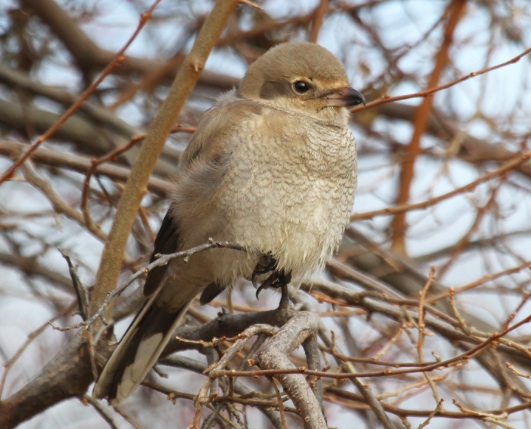
Northern Shrike, Ryan Schain
Great Plains
The southerly and southwesterly flow that was pervasive during this period across the region significantly slowed migration progress, with few nights and locations experiencing anything more than light flights. Locally light flights on Saturday night were the highlight in terms of bird migration for the period up to Thursday night. By Thursday night, a frontal boundary had passed to the west, and the central and southern Plains saw moderate to locally heavy flights follow suite.
Top Movers
Increasing
| Species | Increase from Last Week | % of Checklists Reporting |
|---|---|---|
| Snowy Owl | 957% | 3.1 |
| White-winged Scoter | 626% | 1.6 |
| Thayer's Gull | 162% | 1.1 |
| Snow Goose | 25% | 5.3 |
| Hooded Merganser | 33% | 3.2 |
| American Tree Sparrow | 20% | 9.3 |
| Pine Grosbeak | 89% | 0.7 |
| Eared Grebe | 23% | 3.2 |
| Common Loon | 26% | 3.5 |
| Dark-eyed Junco | 8% | 44.9 |
| Cedar Waxwing | 12% | 9 |
| Bohemian Waxwing | 54% | 0.4 |
| Northern Shrike | 19% | 2.1 |
| Townsend's Solitaire | 38% | 1.2 |
| Snow Bunting | 22% | 1.9 |
| Cackling Goose | 16% | 2.7 |
| Lesser Scaup | 0% | 8.4 |
| Rough-legged Hawk | 17% | 1.7 |
| Ross's Goose | 22% | 1 |
| Common Goldeneye | 32% | 1.1 |
| Greater White-fronted Goose | 10% | 5.3 |
| Redhead | 14% | 12.3 |
Decreasing
| Species | Decrease from Last Week | % of Checklists Reporting |
|---|---|---|
| Lincoln's Sparrow | -70% | 2.2 |
| Chipping Sparrow | -62% | 3.2 |
| Field Sparrow | -68% | 1.9 |
| Swamp Sparrow | -64% | 2 |
| Long-billed Dowitcher | -74% | 0.5 |
| Turkey Vulture | -66% | 1.6 |
| Tufted Titmouse | -37% | 8.7 |
| Double-crested Cormorant | -32% | 15.6 |
| Savannah Sparrow | -39% | 6 |
| Song Sparrow | -32% | 14.3 |
| Western Meadowlark | -42% | 4 |
| Common Grackle | -42% | 4.4 |
| Yellow-rumped Warbler | -24% | 16.5 |
| Red-tailed Hawk | -21% | 24.6 |
| Killdeer | -25% | 13.8 |
| Fox Sparrow | -44% | 3.8 |
| Eastern Meadowlark | -36% | 5.1 |
| American Wigeon | -38% | 7 |
| Mourning Dove | -22% | 14.6 |
| Franklin's Gull | -26% | 13.5 |
| Vesper Sparrow | -58% | 1 |
| Northern Flicker | -20% | 28.5 |
| Fish Crow | -96% | 0 |
| Tree Swallow | -86% | 0.1 |
| White-throated Sparrow | -27% | 10.9 |

Pacific Loon, Brian Sullivan
West
Light, late season movements were apparent in the southern reaches of the region last weekend, as more northerly locales experience scattered precipitation. By Monday night, as some of this precipitation cleared out of the Pacific Northwest, light to locally moderate flights took place. But the remainder of the period saw minimal to light movements scattered locally across the West.
Top Movers
Increasing
| Species | Increase from Last Week | % of Checklists Reporting |
|---|---|---|
| Red-breasted Merganser | 118% | 3.3 |
| Brant | 173% | 1.1 |
| Pacific Loon | 78% | 3.3 |
| Black Turnstone | 64% | 3.1 |
| Mew Gull | 50% | 5.4 |
| Peregrine Falcon | 45% | 4.7 |
| Bonaparte's Gull | 28% | 4 |
| Bohemian Waxwing | 599% | 0.3 |
| Surf Scoter | 64% | 7.3 |
| Bufflehead | 17% | 12.6 |
| Brown Pelican | 29% | 7.4 |
| Snow Bunting | 73% | 0.5 |
| Surfbird | 41% | 1.1 |
| Rock Sandpiper | 284% | 0.1 |
Decreasing
| Species | Decrease from Last Week | % of Checklists Reporting |
|---|---|---|
| Red-naped Sapsucker | -51% | 0.7 |
| Prairie Falcon | -50% | 0.5 |
| Chestnut-collared Longspur | -76% | 0.1 |
| Clay-colored Sparrow | -78% | 0.1 |
| Red-throated Pipit | -90% | 0 |
| Grasshopper Sparrow | -79% | 0 |
| Cassin's Kingbird | -22% | 2.5 |
| Chipping Sparrow | -29% | 1.9 |
| Sage Thrasher | -69% | 0.1 |
| Lewis's Woodpecker | -45% | 0.4 |
| Clark's Nutcracker | -35% | 0.6 |
| Northern Pintail | -17% | 5.9 |
| Gadwall | -17% | 8.7 |
| Common Grackle | -51% | 0.2 |
| Wood Duck | -17% | 2.4 |
–––––––––––––––––––––––––––––––––––
Farnsworth and Van Doren




